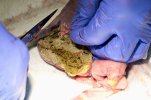bolson tortoise
This is a large terrestrial tortoise approaching 40 cm in shell length (fossils may have reached one metre). It prefers low grade slopes (0.5% to 2% grade), fine textured soil (averaging 48% sand and 32% silt with both gravel and clay each comprising 10% of the total)
gopher tortoise
In southern Georgia, G. polyphemus still occurs on sand ridges in at least 81 counties. Some of the largest and most continuous populations are found in the western Fall Line Sand Hills
While some hatchlings immediately construct burrows, others may utilize adult burrows or merely seek shelter opportunistically under sand or litter
The gopher tortoise generally occurs on well-drained to dry soils, with adequate sand depths (in excess of one metre) for burrowing.
Specimens from dry, sandy areas are lighter in colour than those from wetter clay regions (Auffenberg 1969)
T. graeca
Where sympatric with T. hermanni, the two species tend towards habitat segregation, with T. graeca occupying open coastal sand dune systems at the western extreme of its range in Greece.
A wide variety of habitats and bioclimatic zones are inhabited over the entire species' range. Typically found in semi-arid hill scrub, open maquis and garigue type vegetation and at coastal sites, on sand dune ecosystems
The Egyptian tortoise is found principally in Egypt, but its range extends into parts of Israel and Libya, in the region of Cyrenaica. In Egypt it is confined to the northern part of the country, in the low-lying areas of Alexandria, Port Said, Damiette, and along the Mediterranean coast of the Sinai. Its distribution is interrupted by the alluvial plain of the Nile delta. In Israel, its distribution is limited to sandy areas and dunes in the western Negev and to isolated sand areas of Mishor Yamin and Mishor Rotem.
A similar high density of tortoises occurs on Dassen Island off the Cape west coast. Preliminary transects on this flat, sand covered granite island (19 m high, 220 hectares) indicate that as many as 10-20,000 tortoises may be present
Milstein (1968) found two specimens hibernating in mid-May. They were almost half-buried in soft red sand
Horsfield's Tortoise
while the most favoured habitats were the loess foothills and sandy deserts of the Badkhaz and Karabil plateaus
Star tortoises
are highly generalized in habitat preference. Deraniyagala (1939) reported that they inhabit sand dunes, brush wood, scrub forests, and park jungle in Sri Lanka.
This is a large terrestrial tortoise approaching 40 cm in shell length (fossils may have reached one metre). It prefers low grade slopes (0.5% to 2% grade), fine textured soil (averaging 48% sand and 32% silt with both gravel and clay each comprising 10% of the total)
gopher tortoise
In southern Georgia, G. polyphemus still occurs on sand ridges in at least 81 counties. Some of the largest and most continuous populations are found in the western Fall Line Sand Hills
While some hatchlings immediately construct burrows, others may utilize adult burrows or merely seek shelter opportunistically under sand or litter
The gopher tortoise generally occurs on well-drained to dry soils, with adequate sand depths (in excess of one metre) for burrowing.
Specimens from dry, sandy areas are lighter in colour than those from wetter clay regions (Auffenberg 1969)
T. graeca
Where sympatric with T. hermanni, the two species tend towards habitat segregation, with T. graeca occupying open coastal sand dune systems at the western extreme of its range in Greece.
A wide variety of habitats and bioclimatic zones are inhabited over the entire species' range. Typically found in semi-arid hill scrub, open maquis and garigue type vegetation and at coastal sites, on sand dune ecosystems
The Egyptian tortoise is found principally in Egypt, but its range extends into parts of Israel and Libya, in the region of Cyrenaica. In Egypt it is confined to the northern part of the country, in the low-lying areas of Alexandria, Port Said, Damiette, and along the Mediterranean coast of the Sinai. Its distribution is interrupted by the alluvial plain of the Nile delta. In Israel, its distribution is limited to sandy areas and dunes in the western Negev and to isolated sand areas of Mishor Yamin and Mishor Rotem.
A similar high density of tortoises occurs on Dassen Island off the Cape west coast. Preliminary transects on this flat, sand covered granite island (19 m high, 220 hectares) indicate that as many as 10-20,000 tortoises may be present
Milstein (1968) found two specimens hibernating in mid-May. They were almost half-buried in soft red sand
Horsfield's Tortoise
while the most favoured habitats were the loess foothills and sandy deserts of the Badkhaz and Karabil plateaus
Star tortoises
are highly generalized in habitat preference. Deraniyagala (1939) reported that they inhabit sand dunes, brush wood, scrub forests, and park jungle in Sri Lanka.
